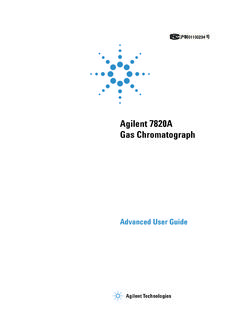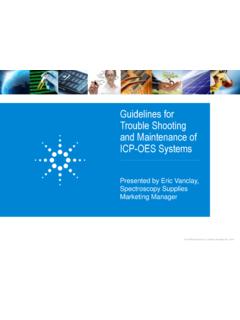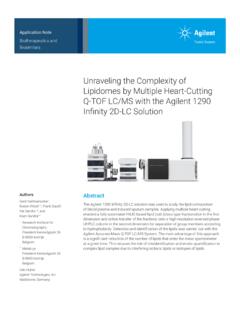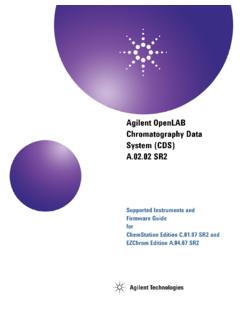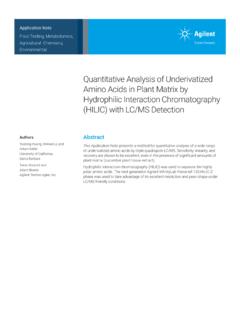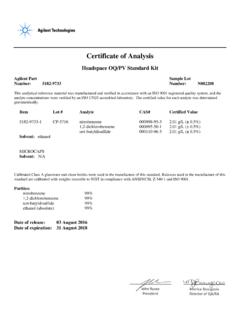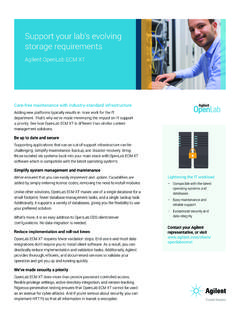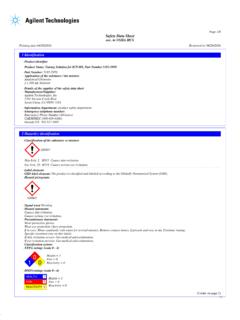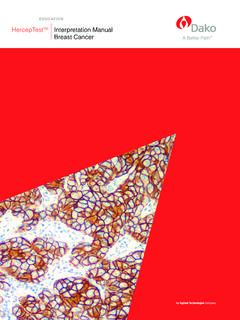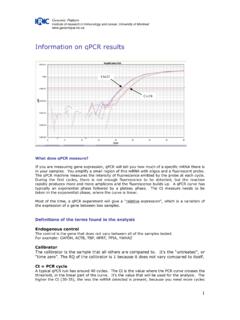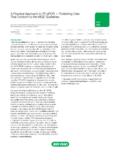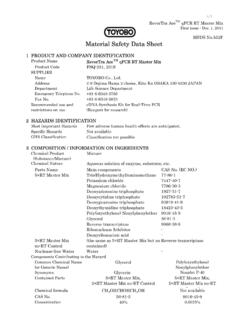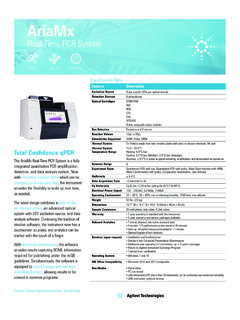Transcription of Introduction to Quantitative PCR - Agilent
1 Methods and Applications GuideIntroduction to Quantitative PCR Introduction to Quantitative PCR Methods and Applications Guide IN 70200 D US and Canada Orders: 800-227-9770 x3 Technical Service: 800-227-9770 x2 For a list of worldwide distributors, please visit Agilent Technologies, Inc. 2012 Table of Contents Table of Contents .. 2 Introduction to Quantitative PCR .. 1 Real-Time vs. Endpoint Quantitative PCR .. 2 Experimental Design .. 5 Methods of Quantification .. 6 Standard Curve .. 6 Relative Quantification .. 8 qpcr Chemistry Options .. 9 Primer and Probe Design .. 16 Dye and Quencher Choice .. 20 qpcr Reagent Choice .. 21 Probe and Primer Synthesis .. 24 Reference Dye Considerations .. 24 Nucleic Acid Sample Preparation .. 26 DNA .. 26 RNA.
2 26 Total RNA vs. mRNA .. 26 Measuring RNA Quality .. 27 Storage of RNA .. 29 Using Cell Lysates in Real-Time qpcr .. 30 Reverse Transcription Considerations .. 32 Converting RNA to cDNA with the AffinityScript qpcr cDNA Synthesis Kit .. 32 Reverse Transcription Priming .. 32 Oligo(dT) Priming .. 32 Random Priming .. 33 Combined Oligo(dT)/Random Priming .. 34 Gene-Specific Priming .. 34 QRT-PCR Reactions: One-step vs. Two-step .. 35 One-step .. 35 Two-step .. 36 Controls for Quantitative PCR 38 Positive Controls .. 38 Negative Controls .. 41 Passive Reference Dye .. 42 Approaches to Normalizing Gene Expression .. 43 Variability in Starting Cell Number .. 43 Variability in the Reverse Transcription Reaction .. 44 Sample Normalization using Reference Genes .. 44 Assay Optimization .. 47 Primer Optimization Guidelines.
3 47 Primer Optimization with SYBR Green I .. 48 Primer Optimization with Fluorescent Probes .. 52 Probe Concentration Optimization Guidelines .. 52 Probe Optimization Data Analysis .. 52 Standard Curves for Analysis of qpcr Assay Performance .. 53 PCR Reaction Efficiency .. 54 Precision .. 54 Sensitivity .. 54 Standard Curve Examples .. 55 Further Optimization .. 56 Multiplex Assay Considerations .. 56 The Ideal Assay .. 58 qpcr Experiment Data Analysis .. 59 Ensuring Your Ct Values are Accurate .. 59 Raw Fluorescence Values .. 59 Setting the Baseline .. 60 Setting the Threshold .. 63 Dissociation Curves (Only for SYBR Green I) .. 65 Controls .. 66 Replicate Agreement .. 67 Standard Curve Quantification .. 67 Relative or Comparative Quantification .. 69 Ct Method .. 69 Efficiency-corrected Comparative Quantitation.
4 70 Comparative Quantitation Module in the MxPro Software .. 71 Qualitative PCR .. 80 Other Applications of Plate Reads and Endpoint qpcr .. 81 Multiple Experiment Analysis .. 83 Applications .. 83 Considerations for Multiple Experiment Analysis .. 83 Threshold Determination in Multiple Experiment Analysis .. 84 Multiple Experiment Analysis Applications: How-To Examples .. 88 Application 1: How to Find the Initial Template Quantity in an Unknown Sample Using Standards from a Separate Experiment .. 88 Application 2: How to Normalize GOI Data to an Assay from a Separate Experiment .. 90 Appendix .. 93 Primer Optimization Reaction Example .. 93 Probe Optimization Reaction Example .. 95 References .. 96 Fast Track Education Program .. 97 qpcr Glossary .. 98 Experiment and Chemistry Terms.
5 98 Sample- and Well-Type Terms .. 100 Analysis Terms .. 101 Fluorescence Reading Terms .. 103 qpcr References and Useful Websites .. 105 qpcr References .. 105 Useful Websites .. 105 Product Listings & Ordering Information .. 107 Endnotes .. 108 1 Introduction to Quantitative PCR Whether you are a novice or experienced user, our goal is to ensure that you are running Quantitative PCR ( qpcr ) experiments quickly, efficiently, and affordably. Our Mx family of qpcr Systems, MxPro qpcr Software, premiere qpcr Systems Service Program, complete line of qpcr and QRT- PCR reagents, and Fast Track qpcr Education Program is the total package for your qpcr research. At Agilent Technologies, we are committed to providing you with the most comprehensive and easy- to- use support programs.
6 The Introduction to Quantitative PCR Methods and Applications Guide was written by our Field Applications Scientists and Technical Services Department in order to ensure that you are provided with the start- up support necessary to begin using your qpcr instrument, as well as an explanation of the theoretical basis for the materials used in qpcr techniques. This guide is also designed for more experienced scientists, who will find clear guidelines for data analysis and interpretation of results to ensure better quality experimental results. You will find that Introduction to Quantitative PCR provides clear steps for learning the details of qpcr methods, how to use these methods effectively, and the most appropriate analysis techniques to provide reliable and reproducible results.
7 The guide starts with a brief Introduction to qpcr and experimental design. This is perhaps the most crucial step in the qpcr process as it lays the groundwork for every other aspect of the assay. The guide then discusses important experimental design specifics such as primer and probe design, dye and reagent choice, assay optimization, and data analysis. Detailed discussions on Sample Preparation, Reverse Transcription Considerations, Gene Expression Normalization and Multiple Experiment Analysis are also included. 2 Real-Time vs. Endpoint Quantitative PCR PCR technology is widely used to aid in quantifying DNA because the amplification of the target sequence allows for greater sensitivity of detection than could otherwise be achieved.
8 In an optimized reaction, the target quantity will approximately double during each amplification cycle. In Quantitative PCR ( qpcr ), the amount of amplified product is linked to fluorescence intensity using a fluorescent reporter molecule. The point at which the fluorescent signal is measured in order to calculate the initial template quantity can either be at the end of the reaction (endpoint semi- Quantitative PCR) or while the amplification is still progressing (real- time qpcr ). In endpoint semi- Quantitative PCR, fluorescence data are collected after the amplification reaction has been completed, usually after 30 40 cycles, and this final fluorescence is used to back- calculate the amount of template present prior to PCR.
9 This method of quantification can give somewhat inconsistent results, however, because the PCR reaction efficiency can decrease during later amplification cycles as reagents are consumed and inhibitors to the reaction accumulate. These effects can vary from sample to sample, which will result in differences in final fluorescence values that are not related to the starting template concentrations. As shown in Figure 1, the data collected at the reaction endpoint are not uniform even when identical samples are being amplified. The data spread of endpoint values demonstrates that data measured following amplification are not uniform or reproducible enough to be useful for the precise measurements required for Quantitative analysis.
10 For applications that do not require a great deal of copy number discrimination, such as qualitative studies which just seek to determine whether or not a target sequence of interest is present or not, end-point measurements are generally sufficient. The more sensitive and reproducible method of real- time qpcr measures the fluorescence at each cycle as the amplification progresses. This allows quantification of the template to be based on the fluorescence signal during the exponential phase of amplification, before limiting reagents, accumulation of inhibitors, or inactivation of the polymerase have started to have an effect on the efficiency of amplification.
